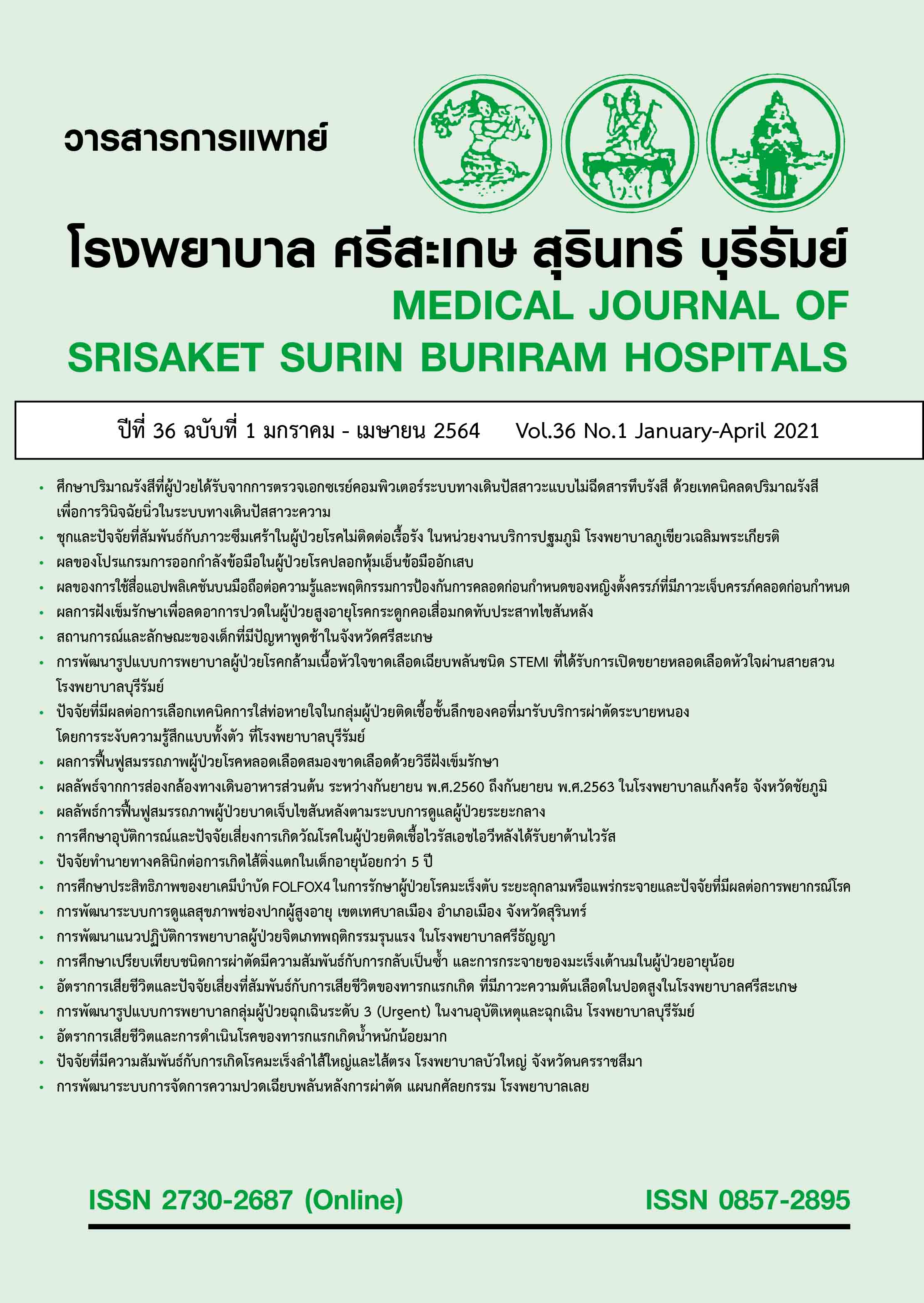อัตราการเสียชีวิตและปัจจัยเสี่ยงที่สัมพันธ์กับการเสียชีวิตของทารกแรกเกิด ที่มีภาวะความดันเลือดในปอดสูงในโรงพยาบาลศรีสะเกษ
Main Article Content
บทคัดย่อ
หลักการและเหตุผล: ภาวะความดันเลือดในปอดสูงในทารกแรกเกิดเป็นภาวะที่รุนแรง ทำให้มีภาวะแทรกซ้อนจากการรักษาและอัตราการเสียชีวิตค่อนข้างสูง
วัตถุประสงค์: เพื่อศึกษาอัตราการเสียชีวิตและปัจจัยเสี่ยงที่สัมพันธ์กับการเสียชีวิตของทารกแรกเกิดที่มีภาวะความดันเลือดในปอดสูงในโรงพยาบาลศรีสะเกษ
วิธีการศึกษา: การศึกษาข้อมูลแบบย้อนหลัง โดยเก็บข้อมูลจากเวชระเบียนผู้ป่วยในของทารกแรกเกิดที่ได้รับการวินิจฉัยว่ามีภาวะความดันเลือดในปอดสูง (PPHN) ที่เข้ารับการรักษาในหอผู้ป่วยทารกแรกเกิดวิกฤต (NICU) โรงพยาบาลศรีสะเกษ ในระหว่างวันที่ 1 มกราคม พ.ศ.2558 ถึง 31 ธันวาคม พ.ศ.2563
ผลการศึกษา: ทารกที่เข้าเกณฑ์ในการศึกษานี้ 84 ราย (2.9 รายต่อพันการเกิดมีชีพ) พบเพศชายมากกว่าเพศ หญิง (1.6 ต่อ 1) คลอดโดยวิธี cesarean section ร้อยละ 46.4 อายุครรภ์เฉลี่ย 37.9±2.3 สัปดาห์ น้ำหนักแรกเกิดเฉลี่ย 2913.3±647 กรัม อัตราการเสียชีวิตของทารกแรกเกิดที่มีภาวะ PPHN เท่ากับร้อยละ 64 (54/84) ปัญหาของมารดาที่พบบ่อยที่สุดคือ ภาวะขี้เทาปนในน้ำคร่ำ (ร้อยละ 33.3) การวินิจฉัยเบื้องต้นที่พบบ่อยที่สุดคือ ภาวะปอดอักเสบแต่กำเนิด (ร้อยละ 42.9) ทารกทุกคนได้รับการช่วยหายใจด้วยเครื่องช่วยหายใจความถี่สูง (high frequency oscillatory ventilation, HFOV) โดยมีค่า mean airway pressure (MAP) สูงสุดเฉลี่ย 19.3±4.5 cmH2O ค่า delta P สูงสุดเฉลี่ย 46.5±10.9cmH2O ภาวะแทรกซ้อนที่พบบ่อยที่สุดคือภาวะปอดอักเสบในโรงพยาบาล (ร้อยละ 42.9) ปัจจัยเสี่ยงที่สัมพันธ์กับการเสียชีวิตของทารกแรกเกิดที่มีภาวะ PPHN ได้แก่ ทารกที่มีภาวะ meconium aspiration syndrome (odds ratio 4.136, P 0.019) และทารกที่ใช้เครื่องช่วยหายใจความถี่สูง (HFOV) ที่มีค่า mean airway pressure (MAP) สูงสุดมากกว่าเท่ากับ 20cmH2O (odds ratio 7.368, P 0.015)
สรุปผล: อัตราการเสียชีวิตของทารกแรกเกิดที่มีภาวะ PPHN เท่ากับร้อยละ 64 ปัจจัยเสี่ยงที่สัมพันธ์กับการเสียชีวิตได้แก่ ภาวะ meconium aspiration syndrome และทารกที่ใช้เครื่องช่วยหายใจความถี่สูง (HFOV) ที่มีค่า mean airway pressure (MAP) สูงสุดมากกว่าเท่ากับ 20cmH2O
คำสำคัญ: ภาวะความดันเลือดในปอดสูงในทารกแรกเกิด อัตราการเสียชีวิตปัจจัยเสี่ยง
Article Details
เอกสารอ้างอิง
Oishi PE, Keller RL. When persistent pulmonary hypertension of the newborn persists. Pediatr Crit Care Med 2012;13(2):224-5.
Steinhorn RH. Neonatal pulmonary hypertension. Pediatr Crit Care Med 2010;11(2 Suppl):S79-84.
Walsh-Sukys MC, Tyson JE, Wright LL, Bauer CR, Korones SB, Stevenson DK, et al. Persistent pulmonary hypertension of the newborn in the era before nitric oxide: practice variation and outcomes. Pediatrics 2000;105(1 Pt 1):14-20.
Roofthooft MT, Elema A, Bergman KA, Berger RM. Patient characteristics in persistent pulmonary hypertension of the newborn. Pulm Med 2011;2011:858154.
Steurer MA, Jelliffe-Pawlowski LL, Baer RJ, Partridge JC, Rogers EE, Keller RL. Persistent Pulmonary Hypertension of the Newborn in Late Preterm and Term Infants in California. Pediatrics 2017;139(1):e20161165.
วรนาฏ จันทร์ขจร, อำนวยพร อภิรักษากร. ผลการรักษาภาวะความดันเลือดปอดสูงในทารกแรกเกิดในโรงพยาบาลตติยภูมิ. วารสารกุมารเวชศาสตร์ 2563;59(2):131-8.
Mathew B, Lakshminrusimha S. Persistent Pulmonary Hypertension in the Newborn.Children (Basel) 2017;4(8):63.
Jain A, McNamara PJ. Persistent pulmonary hypertension of the newborn: Advances in diagnosis and treatment. Semin Fetal Neonatal Med 2015;20(4):262-71.
Razzaq A, IqbalQuddusi A, Nizami N. Risk factors and mortality among newborns with persistent pulmonary hypertension.Pak J Med Sci 2013;29(5):1099-104.
Nakwan N, Jain S, Kumar K, Hosono S, Hammoud M, Elsayed YY, et al. An Asian multicenter retrospective study on persistent pulmonary hypertension of the newborn: incidence, etiology, diagnosis, treatment and outcome. J Matern Fetal Neonatal Med 2020;33(12):2032-2037.
ธีรศักดิ์ อุดมศรี. การศึกษาภาวะความดันหลอดเลือดปอดสูงในทารกแรกเกิดในโรงพยาบาลกระบี่. กุมารเวชสาร 2558;22(1):23-30.
นพวรรณ พงศ์โสภา. ภาวะความดันเลือดในปอดสูงในทารกแรกเกิด โรงพยาบาลสุราษฎร์ธานี. วารสารวิชาการแพทย์เขต 11 2560;31(1):49-59.
Baquero H, Soliz A, Neira F, Venegas ME, Sola A. Oral sildenafil in infants with persistent pulmonary hypertension of the newborn: a pilot randomized blinded study. Pediatrics 2006;117(4):1077-83.
Kahveci H, Yilmaz O, Avsar UZ, Ciftel M, Kilic O, Laloglu F, et al. Oral sildenafil and inhaled iloprost in the treatment of pulmonary hypertension of the newborn. Pediatr Pulmonol 2014;49(12):1205-13.
Janjindamai W, Thatrimontrichai A, Maneenil G, Chanvitan P, Dissaneevate S. Effectiveness and safety of intravenous iloprost for severe persistent pulmonary hypertension of the newborn. Indian Pediatr 2013;50(10):934-8.
Jaroensri S, Kamolvisit W, NakwanN.Risk factor analysis of pneumothorax associated with persistent pulmonary hypertension of the newborn in Thai neonates. J Matern Fetal Neonatal Med 2020;33(24):4090-5.
Nakwan N, Pithaklimnuwong S. Acute kidney injury and pneumothorax are risk factors for mortality in persistent pulmonary hypertension of the newborn in Thai neonates. J Matern Fetal Neonatal Med 2016;29(11):1741-6.
Mat Bah MN, Tan RYH, Razak H, Sapian MH, Abdullah N, Alias EY. Survival and associated risk factors for mortality among infants with persistent pulmonary hypertension of the newborn in Malaysia. J Perinatol 2021;41(4):786-793.
Nair J, Lakshminrusimha S. Update on PPHN: mechanisms and treatment. Semin Perinatol 2014;38(2):78-91.


